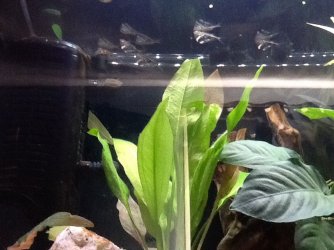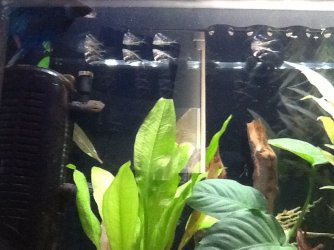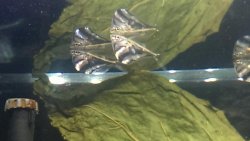Well today I got delivery of my shrimp and hatchetfish for betta tank.i was waiting for James brown to go on the rampage but he seems quite happy for now with his new tank mates.i must say the colours on these little chaps are outstanding.photo not so good but will get more
You are using an out of date browser. It may not display this or other websites correctly.
You should upgrade or use an alternative browser.
You should upgrade or use an alternative browser.
Marbled Hatchetfish
- Thread starter gmc1
- Start date
VERY nice, I do like marbled hatchetfish, have seen these in LFS a number of times, a lovely and actually an interesting specie imo.
The only thing thats stopping me from purchasing these hatchetfish is the fact my tanks are open topped, and these guys are jumpers.
I'd love to see a good closeup pic of one of these guys
The only thing thats stopping me from purchasing these hatchetfish is the fact my tanks are open topped, and these guys are jumpers.
I'd love to see a good closeup pic of one of these guys
Hard to tell from those photos, but I would surmise you have the "vesca" form of this species (Carnegiella strigata) in which the mid-band across the thorax is divided into two branches from the start on the ventral or lower edge of the keel. The other form has a much thicker mid-band that does not divide until about half-way across the thorax. The former is also often a brownish-black whereas the latter is pure black; this colour difference is easiest to see when both forms are in the same aquarium. There are also differences in the number of rays in the anal fin of the two forms.
The species in the genus Carnegiella are all polytypic, which means that there are two or more distinct populations that differ externally, as here in the mid-band across the thorax, in the colouration and the anal fin rays. At one time, there were five recognized species of this "marble" hatchetfish, which Weitzman (1960) reclassified as two. Gery (1977) suggested that these were likely subspecies, but Weitzman & Palmer (2003) went further and placed them together as one distinct species. The forms are specific to certain localities, but in a few areas such as the middle and upper Amazon and the Rio Purus, both forms are present. Going from memory, I cannot remember if they have actually been found living side by side, or just in different localities in the same watercourse.
This is one of my favourite species. As Ch4rlie said, keep the tank well covered; they are prone to jumping, especially during darkness. A couple times I have found one dried on the floor in the morning, and always when I had inadvertently left the cover glass open by just an inch. A few floating plants will be appreciated. The species in this genus prefer remaining right at the surface, but they seem to like some floating plants around them. And keep a watchful eye on the Betta...it may decide to nip the hatchets.
Byron.
The species in the genus Carnegiella are all polytypic, which means that there are two or more distinct populations that differ externally, as here in the mid-band across the thorax, in the colouration and the anal fin rays. At one time, there were five recognized species of this "marble" hatchetfish, which Weitzman (1960) reclassified as two. Gery (1977) suggested that these were likely subspecies, but Weitzman & Palmer (2003) went further and placed them together as one distinct species. The forms are specific to certain localities, but in a few areas such as the middle and upper Amazon and the Rio Purus, both forms are present. Going from memory, I cannot remember if they have actually been found living side by side, or just in different localities in the same watercourse.
This is one of my favourite species. As Ch4rlie said, keep the tank well covered; they are prone to jumping, especially during darkness. A couple times I have found one dried on the floor in the morning, and always when I had inadvertently left the cover glass open by just an inch. A few floating plants will be appreciated. The species in this genus prefer remaining right at the surface, but they seem to like some floating plants around them. And keep a watchful eye on the Betta...it may decide to nip the hatchets.
Byron.
Fish of the month Charlie?Ch4rlie said:
I'd love to see a good closeup pic of one of these guys
So far so good.these guys really are a pleasure to watch so I hope all goes well.my biggest surprise is the behaviour of James brown.i thought he would be a bit aggresive but he seems to enjoy them.i will keep trying to get a better photo but because of there surface dwelling it's hard with the led light.thanks for info.
Pic
Pic
Attachments
Not that it matters, but just for the record...those are not the "vesca" form that I thought fromthe earlier less clear photos, but the other. I actually prefer this form of the species. It is the one most prevalent in the middle and lower Amazon area, such as the Rio Negro, and south. B.
Similar threads
- Replies
- 12
- Views
- 461





